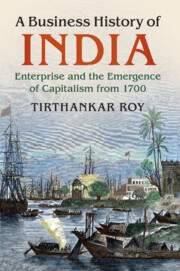Book contents
- A Business History of India
- A Business History of India
- Copyright page
- Dedication
- Contents
- Figures
- Maps
- Tables
- Boxes
- Preface
- 1 Introduction
- 2 The Baseline at 1700
- 3 The Indian Ocean Sphere: 1700–1850
- 4 Capital and Empire (1850–1930)
- 5 Capital and Empire (1850–1930)
- 6 State and Industrialisation: 1930–1950
- 7 State and Industrialisation: 1950–1980
- 8 Revival: 1980–2000
- 9 Capital and Globalisation: 2000–2015
- 10 Conclusion
- References
- Index
6 - State and Industrialisation: 1930–1950
Published online by Cambridge University Press: 20 March 2018
- A Business History of India
- A Business History of India
- Copyright page
- Dedication
- Contents
- Figures
- Maps
- Tables
- Boxes
- Preface
- 1 Introduction
- 2 The Baseline at 1700
- 3 The Indian Ocean Sphere: 1700–1850
- 4 Capital and Empire (1850–1930)
- 5 Capital and Empire (1850–1930)
- 6 State and Industrialisation: 1930–1950
- 7 State and Industrialisation: 1950–1980
- 8 Revival: 1980–2000
- 9 Capital and Globalisation: 2000–2015
- 10 Conclusion
- References
- Index
Summary
The temporary collapse of exports during the Great Depression reduced the capacity of firms to hire, borrow, or buy machines abroad. Industrialisation did not stall, for protectionist tariffs were made available from the mid-1920s. Protection was selective, and did not amount to discarding the old trading order. But protectionism established industrialisation as a priority for the state.
The average tariff rate in India had been going up from before the Great Depression (Fig. 6.1). Historians of Indian industrialisation explain the trend in relation to India's changed position within the Empire after World War I. The rulers saw the contribution of Indian industry to the war effort as sufficiently valuable to consider this concession. The move would not hurt British interests too much, for protectionism could be modified to protect the customs union. Imperial goods would still enter India at low tariffs whereas goods from other emerging economies, especially Japan, would face barriers.
State aid was not confined to protection. In fact, in the aftermath of the depression, all types of business had to appeal to the state for help. The formation of elected legislature in the provinces under two constitutional reforms (1919 and 1935) empowered politicians and campaigners to intervene in favour of indigenous capitalists. But although the state was more ready to step in, state aid beyond a moderate level of protection and these isolated interventions, was negligible.
The real significance of state aid during these twenty years does not lie in how much was done. It derives instead from the fact that, for the first time in the history of the Empire, industrialisation and not trade became the cause the state should espouse. Besides, whereas trade and finance were served by small firms, industry was in the hands of large firms with political voice. It was the voice of the big industrialist, and not the traders, moneylenders, and artisans that would prevail in the negotiations that unfolded in these twenty years over the future shape of economic policy in India.
This chapter discusses the origins of protectionism and how it changed capitalism in interwar India.
The Origins of Protection for Industry
Import substituting industrialisation or ISI started in the 1920s due to shifts in British colonial policy.2 The realisation that Indian resources had contributed to the allied war effort led to three commissions of enquiry. The Indian Industrial Commission (1916–18) had a mainly fact-finding mission.
- Type
- Chapter
- Information
- A Business History of IndiaEnterprise and the Emergence of Capitalism from 1700, pp. 126 - 152Publisher: Cambridge University PressPrint publication year: 2018



